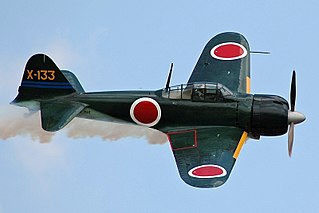
The Mitsubishi A6M "Zero" is a long-range carrier-based fighter aircraft formerly manufactured by Mitsubishi Aircraft Company, a part of Mitsubishi Heavy Industries. It was operated by the Imperial Japanese Navy (IJN) from 1940 to 1945. The A6M was designated as the Mitsubishi Navy Type 0 carrier fighter, or the Mitsubishi A6M Rei-sen. The A6M was usually referred to by its pilots as the Reisen, "0" being the last digit of the imperial year 2600 (1940) when it entered service with the Imperial Navy. The official Allied reporting name was "Zeke", although the name "Zero" was used colloquially as well.

The Mitsubishi A5M, formal Japanese Navy designation Mitsubishi Navy Type 96 Carrier-based Fighter (九六式艦上戦闘機), experimental Navy designation Mitsubishi Navy Experimental 9-Shi Carrier Fighter, company designation Mitsubishi Ka-14, was a WWII-era Japanese carrier-based fighter aircraft. The Type number is from the last two digits of the Japanese imperial year 2596 (1936) when it entered service with the Imperial Navy.

The Yokosuka D4Y Suisei is a two-seat carrier-based dive bomber developed by the Yokosuka Naval Air Technical Arsenal and operated by the Imperial Japanese Navy from 1942 to 1945 during World War II. Development of the aircraft began in 1938. The first D4Y1 was complete in November 1940 and made its maiden flight at Yokosuka the following month.

No. 32 Squadron is a Royal Australian Air Force unit based at RAAF East Sale in Victoria. It currently flies training and transport operations. The squadron was raised in February 1942 for service during World War II. Equipped with Lockheed Hudsons, the squadron was tasked with anti-submarine, anti-shipping operations, bombing and reconnaissance missions in New Guinea. In late 1942, it was withdrawn to Sydney and re-equipped with Bristol Beauforts, which it operated along the east coast of Australia until the war ended. The squadron was disbanded in November 1945, but was re-formed in 1989 with Hawker Siddeley HS 748s. It currently operates Beechcraft King Air 350s.
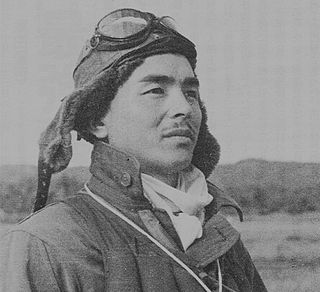
Lieutenant Junior GradeHiroyoshi Nishizawa was a Japanese naval aviator and an ace of the Imperial Japanese Navy Air Service during World War II. Nishizawa was known to his colleagues as 'the Devil' for his breathtaking, brilliant, and unpredictable aerobatics and superb control of his aircraft while in combat. He was a member of the Tainan Kōkūtai's famous "clean up trio" with fellow aces Saburō Sakai and Toshio Ōta and would see action in the New Guinea campaign as well as in the aerial battles over Guadalcanal and over the Solomon Islands. He was killed in 1944 during the Philippines Campaign while aboard an IJN transport aircraft. It is possible that he was the most successful Japanese fighter ace of the war, reportedly telling his last CO that he had achieved a tally of 86 or 87 aerial victories- post war he was linked with scores of 147 or 103, but both of these scores have been considered inaccurate.

Yap International Airport is an airport on Colonia, the main island of the State of Yap in the Federated States of Micronesia. The airport is serviced by United Airlines from Guam. Pacific Missionary Aviation makes periodic trips to the outer island airfields of Ulithi Atoll and Fais Island. Woleai airfield is currently closed for repairs.
Buka Airport is an airport serving Buka Island in the Autonomous Region of Bougainville in Papua New Guinea.
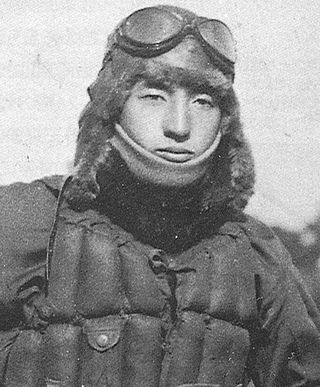
Warrant Officer Kenji Yanagiya was a member of the Imperial Japanese Navy's Zero fighter aces who fought the Battle of Solomon Islands in October 1942 – June 1943. He is best known as the only escort fighter pilot of the Yamamoto mission to have survived the war.
Vunakanau Airfield was an aerodrome located near Vunakanau, East New Britain, Papua New Guinea. The airfield was constructed as a Royal Australian Air Force aerodrome and consisted of an unpaved single runway during World War II. The airfield was captured during the battle of Rabaul in 1942 by the Imperial Japanese and was extensively modified and expanded. Vunakanau was later neutralized by Allied air bombing in May 1944.

Buin is a town on Bougainville Island, and the capital of the South Bougainville District, in the Autonomous Region of Bougainville, in eastern Papua New Guinea. The island is in the northern Solomon Islands Archipelago of the Melanesia region, in the South Pacific Ocean.
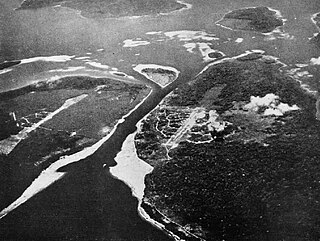
Between 9 March and 5 April 1942 during World War II, forces of the Empire of Japan occupied the islands of Buka and Bougainville in the South Pacific. At that time Buka and Bougainville were part of the Australian-administered Territory of New Guinea. A platoon of Australian commandos from the 1st Independent Company was located at Buka Airfield when the Japanese landed but did not contest the invasion.

Operation I-Go was an aerial counter-offensive launched by Imperial Japanese forces against Allied forces during the Solomon Islands and New Guinea campaigns in the Pacific Theater of World War II. Taking place from 1–16 April 1943, Japanese aircraft—primarily from Imperial Japanese Navy units under the command of Admirals Isoroku Yamamoto and Jinichi Kusaka—attacked Allied ships, aircraft, and land installations in the southeast Solomon Islands and New Guinea. The goal of the operation was to halt the Allied offensives to give Japan time to prepare a new set of defenses in response to recent defeats in the Guadalcanal campaign and in New Guinea at Buna–Gona, Wau, and the Bismarck Sea.
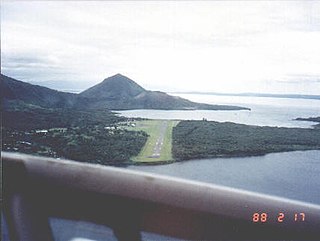
Lakunai Airfield, later known as Rabaul Airport, was an aerodrome located near Rabaul, East New Britain, Papua New Guinea. It was located at the foot of Tavurvur volcano, near Matupit Island. The airport was destroyed by the 1994 eruption that destroyed the town of Rabaul and subsequently a new airport was built and opened at Tokua, on the opposite side of the Rabaul caldera. The former airport was located at 04°13′S152°11′E.
Tobera airfield was an aerodrome located near Tobera, near Keravat, East New Britain, Papua New Guinea. The airfield was constructed by the imperial Japan during World War II. Tobera was later neutralized by Allied air bombing from 1944. The airfield was abandoned after the cessation of hostilities.
Aropa Airport is an airport in Kieta, Bougainville Island, Papua New Guinea.
Buin Airport (IATA:UBI) was an airport located near Kara, Bougainville Island, Papua New Guinea.
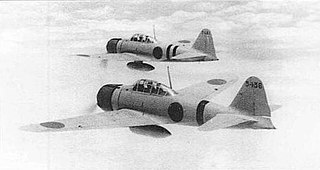
The 12th Air Group was a unit of the Imperial Japanese Navy Air Service (IJNAS) during the Second Sino-Japanese War that operated mainly in the campaigns in the Central China.
The 6th Air Group was a unit of the Imperial Japanese Navy Air Service (IJNAS) during the Pacific War that was involved in Battle of Midway and then extensively in the Guadalcanal Campaign and Solomon Islands Campaign. The air group was redesignated as the 204th Air Group on 1 November 1942.
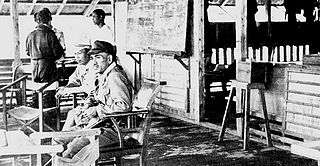
Operation SO and SE were parts of an aerial offensive launched by Imperial Japanese forces against Allied forces staging around Guadalcanal area during the Solomon Islands Campaign in the Pacific Theater of World War II. The aerial offensive took place between 7 and 16 June 1943 and was aimed at destroying Allied air power and shipping. Operation SE involved airstrikes against Allied ships around Guadalcanal that were preparing for Invasion of New Georgia. It was preceded by the First and the Second Operation SO, which both involved fighter sweeps against Guadalcanal from several air groups of Imperial Japanese Navy Air Service. The resulting battles from these operations were dubbed as Lunga Air Battle by the Japanese.













